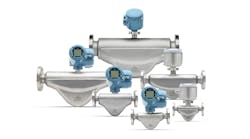Upgrading the operations of a plant most likely involves automation. Software-centric open automation streamlines operations while increasing collaboration and productivity in industrial environments. So, To get the answer, Control’s editor-in-chief, Len Vermillion, talked to Domenico Napoli, future offers leader for process automation at Schneider Electric, during a recent episode of the Control Amplified podcast.
Q: How does software-centric, open automation increase the choices for industrial operators seeking to upgrade process control in their plants?
A: Traditionally, when thinking about process control, a lot of us understand that any type of advancement or improvement in a plant needs more automation. Now, when we think about open automation, it gives us more choices, not only to operators or owners, but also to end users, OEMs and system integrators. We're embarking on a world of plug-and-produce. This isn’t the typical world we have today, where it's plug and engineer and test, figure out what went wrong, and do it all over again.
At Schneider Electric, and working with our partners, we want to overcome the misperceptions that it's impossible to achieve a world where we can get to plug-and-produce, and simplify how different automation technologies and automation vendors all play together.
Q: Let's talk about those misconceptions. Can you discuss the process of what you and your partners are doing to help industry get past them?
A: A lot of people think since it's open, there is an increased cybersecurity risk—everyone has access to it. I want to make sure that everyone has the same understanding. When we say “open,” it doesn't mean fully open-source like many of us are familiar with in the software world. Open, in this case, means it's easier to communicate across multiple different vendors. We can easily have an automation system that includes more than one vendor, and they all work nicely together and talk easily to each other. However, today we must consider gateways and protocol conversions and all those items that can potentially add risk and complexity to getting it started and long-term maintenance. This is simplified in open automation.
Q: Do you think industry understands the misconceptions may not really be as big a problem as they think?
A: I think everybody understands the problems that we have today, and everyone is looking for solutions to overcome these challenges and complexities in the automation space. They’re aware and are looking at what's out there and what's available that can help minimize risk and remove complexities wherever possible.
Q: A basic understanding of open automation means we can segregate software from hardware, but what does that enable? What's the advantage?
A: When we talk about segregating software from hardware, think of the world that we have today with laptops and cell phones, where you have a lot of different hardware vendors and manufacturers using the same underlying software. That's what we want in the industrial automation space, making sure everyone can use the same software, but run that software on their specific hardware, or any vendor's hardware.
This impacts us in different ways. Now, if we like a piece of software or hardware, we don't have to stay tied to that specific vendor for everything. Open automation lets us have fit-for-purpose hardware selections based on what we need to do and where we need to do it, and all running the same software on different hardware variations. Today, many automation solutions limit your hardware selections, and gates close the minute you want to go and use something from a different automation vendor. Protocol transfers and transfer tables also come into play, as well as the extra engineering and complexity required to communicate seamlessly.
Q: That increases organizational collaboration. So, what's the collaborative advantage to open automation?
A: It provides an opportunity for collaboration across all automation vendors in industrial automation. If we look at industrial automation systems today, everybody needs to achieve the same thing. But I’d say no one is an expert in any particular thing, except for a couple of manufacturers.
Let's look at intrinsic safety (IS). Most automation vendors today might have some IS expertise, but it's not their core business. However, there are other manufacturers whose core business is IS. Leveraging open automation lets us connect the experts in a specific field or with a specific item without having so much added integration costs. Open automation mean being able to work with the experts and what they do best, and leveraging that expertise as part of a holistic solution to our customers.
It also helps when we want to reduce and streamline risk. Minimizing potential points of failure is another area where open automation helps. I think most plants have more than one automation provider, and all of these are usually interfaced with each other through gateways and software protocol conversions. Leveraging open automation reduces all of those potential points of failure, and streamlines your operations and automation architecture. You don't need those gateways anymore because everybody's talking the same language and using the same software.
We have engineering tools we've developed at Schneider Electric, such as EcoStruxure™ Automation Expert, which can configure a control strategy once, and eventually deploy to whatever hardware we choose that's part of the open automation family. There's a lot of other collaboration as well, when we think about how the workforce is changing, and how we can apply different types of programming into an automation platform with which more people are familiar.
When we think of the typical programming of industrial automation today, we typically think about the cyclical way of programming versus event-driven automation programming in the IT space. Schneider Electric adopted a new event-driven base of programming, which now opens the doors to a lot more people that are familiar with that type of programming. It opens the potential workforce that end users and customers have access to without having to retrain them on how to program in a cyclical way.





